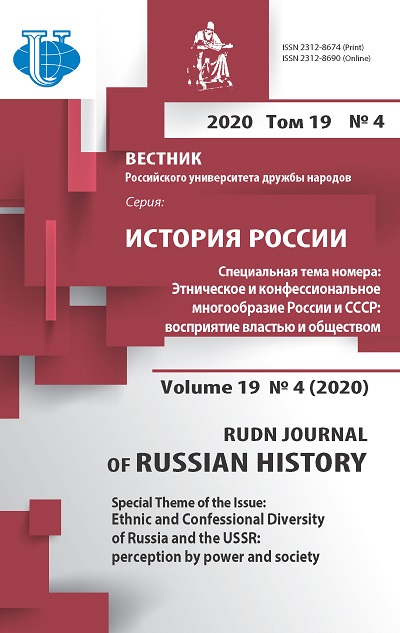Custodians of Holy Places in Central Asia and Russian State (1865-1917)
- Authors: Litvinov V.P.1
-
Affiliations:
- Bunin Yelets State University
- Issue: Vol 19, No 4 (2020): Ethnic and confessional diversity of Russia and the USSR: perception by power and society
- Pages: 781-792
- Section: ETHNIC AND CONFESSIONAL DIVERSITY OF RUSSIA AND THE USSR: PERCEPTION BY POWER AND SOCIETY
- URL: https://journals.rudn.ru/russian-history/article/view/25078
- DOI: https://doi.org/10.22363/2312-8674-2020-19-4-781-792
Cite item
Full text / tables, figures
Abstract
The article discusses the institution of custody of holy places in Central Asia in the pre-revolutionary period (1865-1917). It is indicated that despite the fact that this institution was not legitimatized in Muslim Law (Sharia), nevertheless, custody was quite widespread in the region. It is stated that the sheikhs-custodians were surrounded with mystical worship of the faithful who attributed to them supernatural abilities in the fulfillment of a variety of desires and healing of various diseases. The custody of holy places has always and everywhere been associated with the acquisition of income from pilgrimage. In Central Asia around a holy place, as a rule, a waqf complex was also formed, which made additional significant income to the sheikhs-custodians of holy places. The hereditary order of custody succession, with significant ownership holy places had, often was the cause of conflicts among relatives who had rights to sacred objects. After Russia came to Central Asia, this problem became one of the most important for the government of Turkestan. It was important for Russia to solve the property problem of holy places. In their attempts to solve it, the authorities of Russian Turkestan could not build a clear and understandable system of relations with custodians of holy places. Even after half a century of presence in the region, the authorities had little idea of the number of holy places and real income of their sheikhs-custodians. The author concludes that the reason for such an ineffective activity of Russian authorities in the region in solving problems of holy places was the fear of destroying the order that took shape over the centuries. It, in their opinion, could lead to an increase in anti-Russian feelings in the region.
About the authors
Vladimir P. Litvinov
Bunin Yelets State University
Author for correspondence.
Email: vladlenli@yandex.ru
Doktor Istoricheskikh Nauk [Dr. habil. hist.], Senior Research Fellow, Scientific Research Laboratory
28/1, Kommunarov St., Yelets, 399770, RussiaReferences
- Abashin, S.N. “Islam v byurokraticheskoy praktike tsarskoy administratsii Turkestana (vakufnoye delo dakhbidskogo medrese).” In Sbornik Russkogo Istoricheskogo obshchestva, 163–191. Moscow: Nauka Publ., 2003 (in Russian).
- Abdusamedov, A.I. Islam v SSSR. Osobennosti protsessa sekulyarizatsii v respublikakh sovetskogo Vostoka. Moscow: Mysl' Publ., 1983 (in Russian).
- Abidulin, A. “Symbolism and power during the reign of Sultan Abdul-Hamid II (1876-1909).” Power, no. 10 (2008): 125–128 (in Russian).
- Bartol'd, V.V. Turkestan v epokhu mongol'skogo nashestviya. Moscow: Vostochnaya literature Publ., 1963 (in Russian).
- Bartol'd, V.V. Istoriya Turkestana (konspekt lektsiy). Moscow: Vostochnaya literature Publ., 1964 (in Russian).
- Basilov, V.N. “O perezhitkakh totemizma u Turkmen.” In Trudy Instituta istorii AN, Turkmenskoy SSR, 135–150. Ashkhabad: Akademiya nauk Turkmenskoy SSR Publ., 1963 (in Russian).
- Basilov, V.V. Kul't svyatykh v islame. Moscow: Mysl' Publ., 1970 (in Russian).
- Blinov, A.A. “Religious Formulas and Titles in the Gulf Countries.” Sciences of Europe, no. 20 (2017): 26–38 (in Russian).
- Bol'shakov, O.G. Istoriya Khalifata. Islam v Aravii (570–633). Moscow: «Vostochnaya literatura» Publ., 2000 (in Russian).
- Demidov, S.M. “Magtymy (istoriko-etnograficheskiy etyud).” In Domusul'manskiye verovaniya i obryady v Sredney Azii, 171–173. Moscow: Nauka Publ., 1975 (in Russian).
- Grodekov, N.I. Kirgizy i kara-kirgizy. Syrdar'inskoy oblasti. Yuridicheskiy byt. Tashkent: Tiplitografiya S.I. Lakhtina Publ., 1889 (in Russian).
- Landa, R.G. Islam v istorii Rossii. Moscow: Vostochnaya literature Publ., 1995 (in Russian).
- Litvinov, V.P. Religioznoye palomnichestvo: regional'nyy aspekt (na primere Turkestana epokhi srednevekov'ya i Novogo vremeni). Yelets: YEGU im. I.A. Bunina Publ., 2006 (in Russian).
- Litvinov, V.P. Gosudarstvo i palomnichestvo musul'man v tsarskoy Rossii: turkestanskiy variant (po arkhivnym, pravovym i inym materialam). Yelets: YEGU im. I.A. Bunina Publ., 2016 (in Russian).
- Litvinov, V.P. “Turkestan muslims’ “holy places” as centres of antirussian activities of turkish secret service (second half of 19th – early 20th centuries).” RUDN Journal of Russian History, no. 2 (2016): 45–54 (in Russian).
- Litvinov, V.P. “State and pilgrimage in Turkestan.” Russian History, no. 1 (2017): 139–147 (in Russian).
- Litvinov, V.P. “Regional pilgrimage of Muslims of Russian Turkestan: little-known pages.” Dialogue with Time, no. 58 (2017): 297–306 (in Russian).
- Korostovtsev, M.A. Religiya drevnego Yegipta. Moscow: Nauka Publ., 1976 (in Russian).
- Khoroshkhin, A.P. Sbornik statey, kasayushchikhsya do Turkestanskogo kraya. St. Petersburg: Tipografiya i khromolitografiya A. Transhelya Publ., 1876 (in Russian).
- Mayev, N.A. “Ocherki Bukharskogo khanstva.” In Materialy po statistike Turkestanskogo kraya, 21–23. St. Petersburg: Turkestanskiy statisticheskaya komissiya Publ., 1879 (in Russian).
- Mallitskiy, N. “Ishany i sufizm.” In Sbornik po musul'manstvu, 102–105. Tashkent: Tipo-litografiya brat'yev Portsevykh Publ., 1900 (in Russian).
- Marks, K. “P.V. Annenkovu, 28 dekabrya 1846 g.” In Sochineniya, 508–514. Moscow: Politicheskaya literature Publ., 1962 (in Russian).
- Martynkin, A.V. “Islamskiy faktor v Osmanskoy imperii XVIII–XIX vv.” In Prichernomor'ye. Istoriya, politika, kul'tura, 36–42. Sevastopol': Filial MGU v g. Sevastopole Publ., 2009 (in Russian).
- Nalivkin, V.P. Kratkaya istoriya Kokandskogo khanstva. Kazan: Tipografiya Universiteta Publ., 1886 (in Russian).
- Nalivkin, N.V. Tuzemtsy ran'she i teper'. Tashkent: Tip. «Turkestanskogo Tovarishchestva Pechatnogo Dela» Publ., 1913 (in Russian).
- Ostroumov, N.V. “Kharakteristika religiozno-nravstvennoy zhizni musul'man, preimushchestvenno Sredney Azii.” Pravoslavnoye obozreniye (1881): 67–71.
- Polyakov, S.P. Istoricheskaya etnografiya Sredney Azii i Kazakhstana. Moscow: MGU Publ., 1980 (in Russian).
- Porshneva, O.S. “Concepts and Methods of Sociology in Historical Research.” RUDN Journal of Russian History, no. 2 (2006): 31–39 (in Russian).
- Veselovskiy, N. “Pamyatnik Khodzha Akhrara v Samarkande.” In Vostochnyye zametki, 321–355. St. Petersburg: Tipografiya Imperatorskoy akademii nauk Publ., 1894 (in Russian).
















